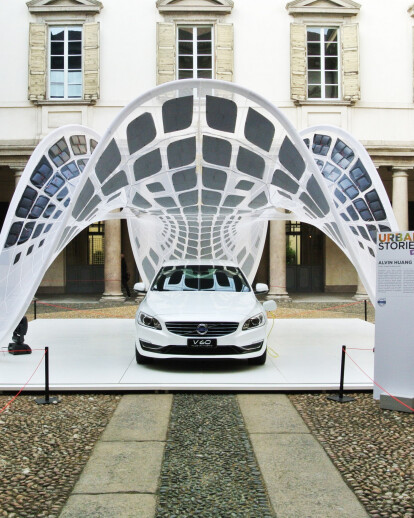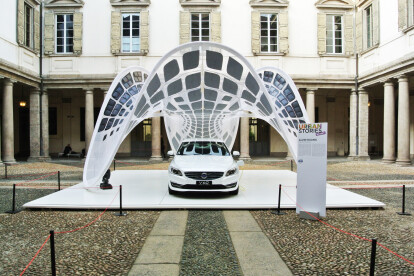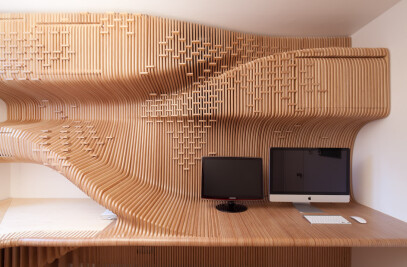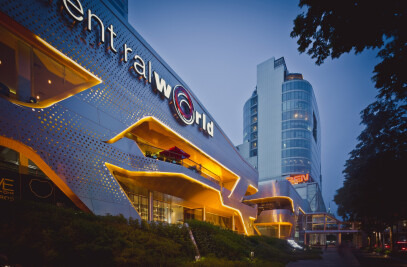FROM COMPETITION WIN TO GROUND-BREAKING STRUCTURE IN 4 MONTHS
Pure Tension, the high-tech, portable solar-powered tensile membrane structuredesigned by Los Angeles-based Synthesis Design + Architecture, is the culmination ofmonths of design refinement, research, and engineering after the firm won Volvo’s“Switch to Pure Volvo” competition, organized by international architecture magazine THEPLAN this past summer.
The pavilion, commissioned by Volvo Car Italia for the new Volvo V60 plug-in hybridelectric car, not only charges the car but also flat-packs to fit in the trunk and assemblesin less than one hour. It is an experimental structure that, similar to a concept car, is aworking prototype that speculates on the future of personal mobility and alternativeenergy sources while also exploring digital design methodologies and innovative structuralsolutions.
For Pure Tension, digital design technologies were harnessed not only to create an iconicpiece of original design but also a vision for the future of transportation.
SDA won the international competition by fulfilling Volvo’s wishes for a portable, yet iconicstructure to showcase the V60 on a press trip through Italy. However, SDA strategicallyadded two key elements to the design that made it stand out: one was the lightweightfabric and aluminum structure that could be collapsed into the trunk of the vehicle anddeployed by two people with ease, the second element was a photovoltaic skin thatcharges the vehicle, essentially the first-of-its-kind portable charging station for a hybridcar.
LOCAL DESIGN/GLOBAL PROCESS
“We wanted to challenge the notion of solar power as something that is an additive pieceof engineering infrastructure,” says Synthesis founder and principal, Alvin Huang. “Thesolar panels became a design feature and design driver, rather than something appliedafter the fact. The goal was to balance utility with beauty,” he adds.
The pavilion is the result of a global effort with design and engineering being carried out inLos Angeles by SDA with Buro Happold engineers, fabrication being done by ChicagobasedFabric Images, solar panels being sourced from Ascent Solar of Texas. Thecompleted pavilion was then shipped to Italy to embark on a 9 month, multi-citypromotional tour starting with the launch event hosted by Volvo in Milan. The next stopfor the pavilion is the EcoMondo Trade Fair of Sustainable Material & Energy inNovember. Additional stops will be announced as they are confirmed. The tour will end atThe Plan Magazine's annual Perspective event in Venice next summer, coinciding withthe Venice Biennalle.
DESIGN, FABRICATION, AND DEPLOYMENTSDA
derived the original design geometry through a conceptual form-finding processknown as dynamic mesh relaxation. The mesh topology produced by SDA was thenfurther developed by Buro Happold, who provided an engineered form-finding processthat takes into account material properties to rationalize the contours. Engineeringrevealed that the SDA form-finding process was within 90-95% accurate with a maximumdeviation of about 2 inches. The continuous tensioned skin of pavilion is articulated bythree hierarchies of geometric pattern that collectively define the geometry and produce avisually engaging moiré effect.
The pavilion is an expression of the tensioned equilibrium between its elastic membraneskin and rigid perimeter frame. The perimeter frame of the structure is defined by 24 CNCbent aluminum pipes with swaged slip fit connections, while the skin is materialized as apair of vinyl encapsulated polyester mesh membranes with a zippered seam and spandexsleeves that wrap the frame. The entire pavilion collapses neatly into two 65”x15”x15” ‘B-cases’ and weighs 150lbs in total and can be assembled and taken down in justunder an hour by a team of two to three people.
252 lightweight flexible photovoltaic panels are embedded within an applied graphic incidence analysis on the structure that found the average annual solar incidence of theskin for 360 degrees of orientation and mapped PV locations to the areas of greatestaverage annual solar incidence. Additionally a MPPT (Maximum Power Point Tracking)controller is utilized to sample the output of the cells, and selectively disable those thatare not collecting enough energy, thereby ensuring that the pavilion is receiving as muchcharge as possible. The pavilion can recharge a fully depleted car in about 12 hours inoptimum sun conditions.
The target goal to achieve the minimum power required to charge the car was 300 wattsof power. The current skin is testing at about 450 watts of power on optimum sunconditions. The wiring of the PV panels is integrated into the seams of the fabric and feeda portable battery system which in turn charges the Volvo V60. Current estimates havethe pavilion recharging a fully depleted car battery in about 12 hours. Technicalrequirements for the charging of the V60 were developed in collaboration with the VolvoDesign Center in Camarillo, CA and solar consultant FTL Solar in New Jersey.












![[C]space DRL10 Pavilion [C]space DRL10 Pavilion](https://archello.com/thumbs/images/2010/10/18/06-36.1506064073.1997.jpg?fit=crop&w=407&h=267&auto=compress)


























